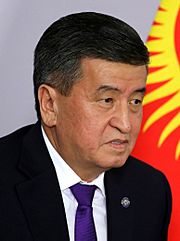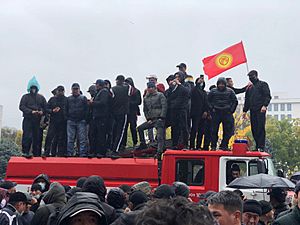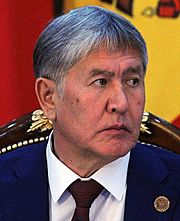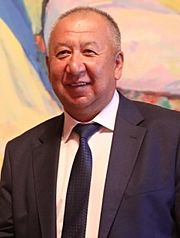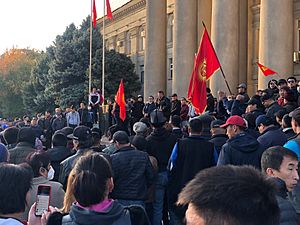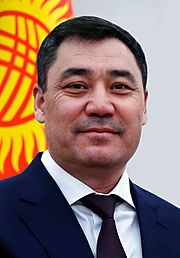2020 Kyrgyz Revolution facts for kids
Quick facts for kids 2020 Kyrgyz Revolution |
||||
|---|---|---|---|---|
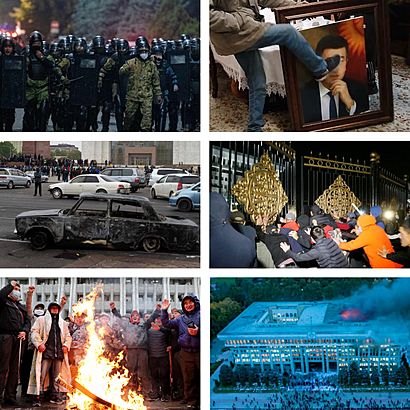
The events of the protests. From left to right:
|
||||
| Date | 5 October 2020 - 15 October 2020 (1 week and 3 days) | |||
| Location | ||||
| Caused by |
|
|||
| Goals |
|
|||
| Methods | Demonstrations, civil disobedience, Riots | |||
| Resulted in |
|
|||
| Concessions given |
|
|||
| Parties to the civil conflict | ||||
|
||||
| Lead figures | ||||
|---|---|---|---|---|
|
||||
| Number | ||||
|
||||
| Casualties | ||||
| Death(s) | 1 | |||
| Injuries | 1,000+ | |||
The 2020 Kyrgyz Revolution, also called the Third Kyrgyz Revolution, started on October 5, 2020. People were upset about the October 2020 Kyrgyz parliamentary election that happened the day before. Many felt the election was unfair, with claims of people buying votes. Because of these protests, the election results were canceled on October 6, 2020.
Later, on October 12, President Sooronbay Jeenbekov declared a special "state of emergency" in the capital city of Bishkek. This was approved by the Parliament the next day. Finally, President Jeenbekov stepped down from his position on October 15, 2020.
Contents
- What Led to the 2020 Kyrgyz Revolution?
- Key Events of the 2020 Kyrgyz Revolution
- October 5: Protests Begin in Bishkek
- October 6: Government Buildings Taken Over
- October 7: Attempts to Form a New Government
- October 9: State of Emergency Declared
- October 10: New Prime Minister and Arrests
- October 12: Second State of Emergency
- October 13: New Speaker and Rejection of PM
- October 15: President Jeenbekov Resigns
- How Other Countries Reacted
- See also
What Led to the 2020 Kyrgyz Revolution?
Kyrgyzstan has had two other big changes in government in the early 2000s. These were the Tulip Revolution in 2005 and the Kyrgyz Revolution of 2010.
In August 2020, the President of Kyrgyzstan, Sooronbay Jeenbekov, said that the parliamentary elections would happen as planned. This was even though the coronavirus pandemic was ongoing. During these elections, some political parties were accused of paying people to vote for them. Also, some journalists reported that they were bothered or even attacked.
Out of all the parties that won seats in the parliament, only one, United Kyrgyzstan, was against the government led by President Jeenbekov. Experts who study politics believe that the 2020 protests were also linked to differences between the country's farming south and its more developed north. In the first election results, most of the winners were from the south and supported Jeenbekov.
Key Events of the 2020 Kyrgyz Revolution
October 5: Protests Begin in Bishkek
The protests started on October 5, 2020. About 1,000 people gathered in Bishkek, the capital of Kyrgyzstan. By evening, the crowd grew to at least 5,000 people. They were protesting the election results and the claims of vote-buying.
After dark, police tried to clear the main square, Ala-Too Square, using tear gas and water cannons. Protesters reportedly threw rocks at police officers, hurting two of them. During this time, former President Almazbek Atambayev was released from prison.
October 6: Government Buildings Taken Over
Early on October 6, 2020, the protesters took back control of Ala-Too Square. They also managed to enter and take over the nearby White House and Supreme Council buildings. They threw papers from windows and set parts of the buildings on fire. One protester died, and 590 others were injured.
After these events, the election officials in Kyrgyzstan canceled the results of the parliamentary elections. A member of the Central Election Commission, Gulnara Jurabaeva, said the commission was thinking about closing down.
Meanwhile, groups against the government said they were now in charge after taking over buildings in the capital. Several local governors reportedly stepped down. President Sooronbay Jeenbekov said that he was facing a "coup d'état," which means someone was trying to illegally take power. He told the BBC that he was "ready to give the responsibility to strong leaders."
Protesters also freed former President Almazbek Atambayev and opposition politician Sadyr Japarov from prison.
Under pressure from the protests, Prime Minister Kubatbek Boronov resigned. A parliamentary member, Myktybek Abdyldayev, was named the new speaker.
October 7: Attempts to Form a New Government
On Wednesday, October 7, opposition parties tried but failed to form a new government. After Prime Minister Boronov resigned, former lawmaker Sadyr Japarov was chosen to replace him. However, other opposition parties said Japarov's appointment was not proper. They suggested their own candidate for prime minister, Tilek Toktogaziyev. Japarov insisted he was the "legitimate prime minister" and was chosen by "the parliament's majority." But President Jeenbekov had not yet confirmed Boronov's resignation. Government websites still listed Boronov as prime minister on October 7.
Crowds gathered again to protest Japarov's nomination and demand President Jeenbekov's resignation. The Ministry of Healthcare reported that at least 768 people injured during the protests had been treated. Reports said that at least three different groups were trying to claim leadership.
At the same time, members of the Kyrgyz parliament started the process to remove President Jeenbekov from office.
October 9: State of Emergency Declared
President Jeenbekov declared a state of emergency. He ordered troops to go into Bishkek. This declaration included a 12-hour curfew until October 21. Gunfire was heard during violent clashes in Bishkek after Jeenbekov's announcement. Jeenbekov officially accepted Boronov's resignation.
October 10: New Prime Minister and Arrests
Kyrgyzstan's special forces arrested former President Almazbek Atambayev in a raid on his home. Former Member of Parliament Sadyr Japarov, who was freed from prison by protesters on October 5, was named as the temporary Prime Minister by Parliament.
October 12: Second State of Emergency
President Jeenbekov declared a second state of emergency in Bishkek. It was set to last from October 12 to October 19. Opposition parties said they planned to remove Jeenbekov from office. Jeenbekov stated he would think about resigning, but only after the political problems were solved. A curfew was put in place from 10 p.m. to 5 a.m. Convoys of soldiers from the Kyrgyz military were sent into the capital city to help control the situation.
October 13: New Speaker and Rejection of PM
Kanat Isaev was chosen as the new Speaker of the Supreme Council. There were no other candidates for the position. Parliament then approved Jeenbekov's second state of emergency declaration, after they had rejected his first one. President Jeenbekov officially rejected Sadyr Japarov's nomination for Prime Minister.
October 15: President Jeenbekov Resigns
Sooronbay Jeenbekov resigned as President of Kyrgyzstan. He did this to try and end the political unrest. He also asked Japarov and other politicians to have their supporters leave the capital so that the people of Bishkek could return to peaceful lives. Japarov then declared himself as the acting president. The Kyrgyzstan Constitution says that the speaker of the Supreme Council should take over this role. However, Kanatbek Isaev refused to become acting president, which led to Japarov taking the position.
How Other Countries Reacted
China's Response
On October 7, the spokeswoman for the Chinese Foreign Ministry, Hua Chunying, said that China is a friendly neighbor. She hoped that all groups in Kyrgyzstan could solve their issues peacefully through talks. China wanted to see stability return to Kyrgyzstan quickly.
Russia's Response
On October 7, Russian President Vladimir Putin said that Russia was worried about the political problems in Kyrgyzstan. He hoped that the former Soviet state would become stable again soon. Russia also said it was talking to all sides involved in the conflict. They hoped that the democratic process would be restored. On October 8, Kremlin spokesman Dmitry Peskov said, "The situation looks like a mess and chaos." He added that Russia was bound by a security agreement to help prevent a complete breakdown in the country.
European Union's Response
The European Union asked all political groups in Kyrgyzstan to follow their country's constitution. They also urged them to solve their disagreements peacefully.
United States' Response
The U.S. Embassy in Bishkek showed support for President Jeenbekov. On October 13, they stated that the United States supported the efforts of President Jeenbekov, political leaders, and others to bring the country back to a constitutional order. They also mentioned that one problem for democracy was that organized crime groups were trying to influence politics and elections.
See also
 In Spanish: Protestas en Kirguistán de 2020 para niños
In Spanish: Protestas en Kirguistán de 2020 para niños
- 2013 Kyrgyzstani protests
- 2020s in political history
- List of protests in the 21st century
- 2021 Kyrgyz presidential election
- 2021 Kyrgyz parliamentary election


